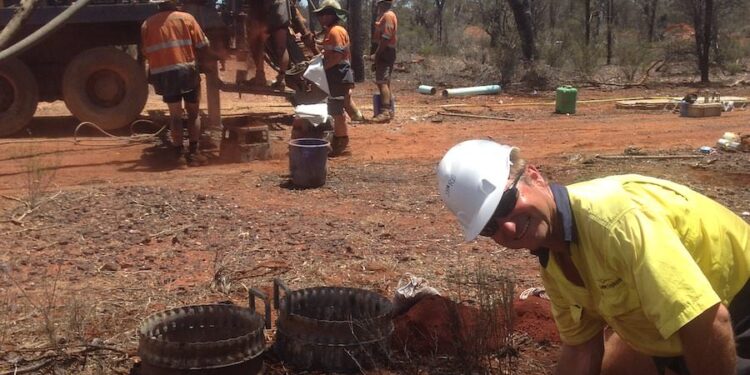Lefroy Exploration Limited (ASX: LEX) has commenced a reverse circulation (RC) drilling programme at the Burns Cu Au prospect located within the company’s wholly owned Eastern Lefroy Project, 70km’s southeast of Kalgoorlie.
The RC drilling is primarily following up and testing the extensions of a new gold zone and opportunity discovered approximately 1600m to the west of the established Burns Cu Au system in an RC drill program in late 2021.
Two holes (LEFR306 & 307) in that program were drilled to evaluate the untested core and margin to the large Burns Intrusion. Vertical hole LEFR307 was designed to evaluate the intrusion but also follow up a prior subtle gold anomaly hosted in transported cover in an historical aircore hole.
The single RC hole intersected a broad gold interval at the base of the transported cover (palaeochannel sediments) and established gold mineralisation in the monzodiorite basement.
The results include:
• A new palaeochannel hosted intercept of 17m @ 1.70g/t Au from 75m including 7m @ 3.68g/t Au from 80m that is open
• The first intersection within the monzodiorite basement of 11m @ 0.42g/t Au from 100m, that supports this as a new host and is also open This single hole established that the basal sediments in the palaeochannel at Burns can host significant gold mineralisation and that the monzodiorite basement beneath is also a host to primary gold mineralisation.
Managing Director, Wade Johnson, said the Burns palaeochannel (channel) is part of the larger Lefroy palaeodrainage that extends east from the St Ives gold operation and where gold mining is conducted at the Neptune pit, hosted by palaeochannel sediments
“We are very keen to be back out RC drilling at Burns firstly with an initial broad test of the palaeochannel system to follow up the intersection in LEFR307, and secondly to focus on the high-grade mineralisation adjacent to discovery hole LEFR260,” Mr Johnson said.
“We will prioritise selected samples from this program for analysis, the results from which will assist in planning further RC drilling along the channel, and the siting of the +1km EIS co-funded diamond hole to probe the depth of this unique intrusion related Cu Au system.”
The company has commenced a wide spaced RC drill program to assess the interpreted deeper part of the channel at Burns where the gold mineralised basal gravels are interpreted to occur. The programme will involve drilling 20 vertical holes totalling 2000m on a nominal 320m by 80m pattern to evaluate approximately 1500m of the channel.
Each hole has a planned downhole depth of 100m to both test the channel sediments and the underlying bedrock. Selected one metre samples from the interval containing the basal gravels will be prioritised for analysis.
Assay results are expected in May 2022. The results from this initial broad evaluation of the channel at Burns will provide the base for follow up more detailed pattern RC drilling.
In addition to the Burns channel programme, two angled RC holes are planned to evaluate the along strike continuity of the high-grade copper gold mineralisation in LEFR260 located on the 0N or baseline section at Burns. That RC hole, known as the Burns discovery hole intersected 38m @ 7.63g/t Au & 0.56% Cu from 134m provided the base for subsequent follow up diamond and RC drilling on 40m or wider step out drill sections.
The two angled RC holes are planned to evaluate the continuity and dimensions of this high-grade zone 20m to the north (20N) and 20m to south (20S) of LEFR260. The results from these holes when interrogated with existing drill data will provide further support for the planning of a single +1000m diamond hole into the Burns System.
Co-funding for this hole is provided under the Exploration Incentive Scheme (EIS) managed by the Department of Mines, Industry Regulation and Safety (DMIRS).
The diamond hole is scheduled to be commenced in June 2022.
For further information please visit: https://lefroyex.com/












